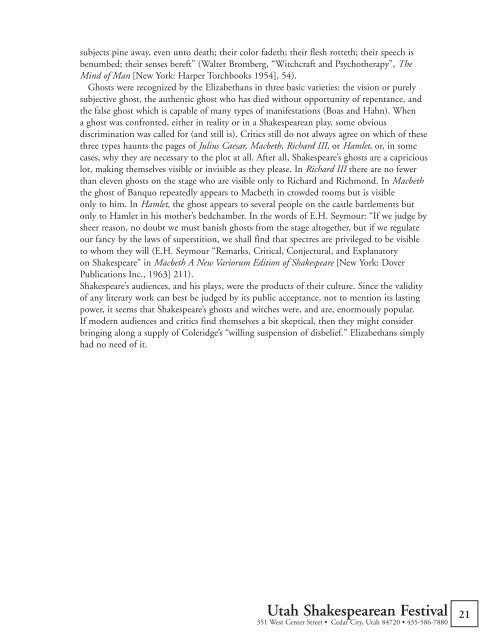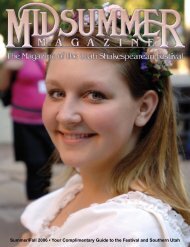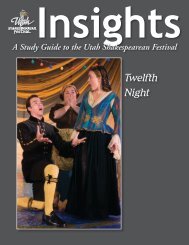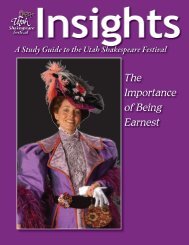20Ghosts, Witches, <strong>and</strong> ShakespeareBy Howard WatersFrom Insights, 2006Some time in the mid 1580s, young Will Shakespeare, for reasons not entirely clear tous, left his home, his wife, <strong>and</strong> his family in Stratford <strong>and</strong> set off for London. It was a timewhen Elizabeth, “la plus fine femme du monde,” as Henry III of France called her, hadoccupied the throne of Engl<strong>and</strong> for over twenty-five years. The tragedy of Mary Stuart waspast; the ordeal of Essex was in the future. Sir Francis Drake’s neutralization of the SpanishArmada was pending <strong>and</strong> rumors of war or invasion blew in from all the great ports.What could have been more exciting for a young man from the country, one who wasalready more than half in love with words, than to be headed for London!It was an exciting <strong>and</strong> frightening time, when the seven gates of London led to a mazeof streets, narrow <strong>and</strong> dirty, crowded with tradesmen, carts, coaches, <strong>and</strong> all manner ofhumanity. Young Will would have seen the moated Tower of London, looking almost likean isl<strong>and</strong> apart. There was London Bridge crowded with tenements <strong>and</strong> at the southernend a cluster of traitors’ heads impaled on poles. At Tyburn thieves <strong>and</strong> murderers dangled,at Limehouse pirates were trussed up at low tide <strong>and</strong> left to wait for the water to rise overthem. At Tower Hill the headsman’s axe flashed regularly, while for the vagabonds therewere the whipping posts, <strong>and</strong> for the beggars there were the stocks. Such was the London ofthe workaday world, <strong>and</strong> young Will was undoubtedly mentally filing away details of whathe saw, heard, <strong>and</strong> smelled.Elizabethan people in general were an emotional lot <strong>and</strong> the ferocity of their entertainmentreflected that fact. Bear-baiting, for example, was a highly popular spectator sport, <strong>and</strong> thestructure where they were generally held was not unlike the theatres of the day. A bear waschained to a stake in the center of the pit, <strong>and</strong> a pack of large dogs was turned loose to bait,or fight, him. The bear eventually tired (fortunately for the remaining dogs!), <strong>and</strong>, well,you can figure the rest out for yourself. Then there were the public hangings, whippings,or drawing <strong>and</strong> quarterings for an afternoon’s entertainment. So, the violence in some ofShakespeare’s plays was clearly directed at an audience that reveled in it. Imagine the effectof having an actor pretend to bite off his own tongue <strong>and</strong> spit a chunk of raw liver that hehad carefully packed in his jaw into the faces of the groundlings!Despite the progressing enlightenment of the Renaissance, superstition was still rampantamong Elizabethan Londoners, <strong>and</strong> a belief in such things as astrology was common (RalphP. Boas <strong>and</strong> Barbara M. Hahna, “The Age of Shakespeare,” Social Backgrounds of EnglishLiterature, [Boston: Little, Brown <strong>and</strong> Co., 1931] 93). Through the position of stars manyElizabethans believed that coming events could be foretold even to the extent of mappingout a person’s entire life.Where witches <strong>and</strong> ghosts were concerned, it was commonly accepted that they existed<strong>and</strong> the person who scoffed at them was considered foolish, or even likely to be cursed.Consider the fact that Shakespeare’s Macbeth was supposedly cursed due to the playwright’shaving given away a few more of the secrets of witchcraft than the weird sisters may haveapproved of. For a time, productions experienced an uncanny assortment of mishaps <strong>and</strong>injuries. Even today, it is often considered bad luck for members of the cast <strong>and</strong> crew tomention the name of the production, simply referred to as the Scottish Play. In preachinga sermon, Bishop Jewel warned the Queen: “It may please your Grace to underst<strong>and</strong> thatwitches <strong>and</strong> sorcerers within these last few years are marvelously increased. Your Grace’sUtah Shakespearean Festival351 West Center Street • Cedar City, Utah 84720 • 435-586-7880
subjects pine away, even unto death; their color fadeth; their flesh rotteth; their speech isbenumbed; their senses bereft” (Walter Bromberg, “Witchcraft <strong>and</strong> Psychotherapy”, TheMind of Man [New York: Harper Torchbooks 1954], 54).Ghosts were recognized by the Elizabethans in three basic varieties: the vision or purelysubjective ghost, the authentic ghost who has died without opportunity of repentance, <strong>and</strong>the false ghost which is capable of many types of manifestations (Boas <strong>and</strong> Hahn). Whena ghost was confronted, either in reality or in a Shakespearean play, some obviousdiscrimination was called for (<strong>and</strong> still is). Critics still do not always agree on which of thesethree types haunts the pages of Julius Caesar, Macbeth, Richard III, or Hamlet, or, in somecases, why they are necessary to the plot at all. After all, Shakespeare’s ghosts are a capriciouslot, making themselves visible or invisible as they please. In Richard III there are no fewerthan eleven ghosts on the stage who are visible only to Richard <strong>and</strong> Richmond. In Macbeththe ghost of Banquo repeatedly appears to Macbeth in crowded rooms but is visibleonly to him. In Hamlet, the ghost appears to several people on the castle battlements butonly to Hamlet in his mother’s bedchamber. In the words of E.H. Seymour: “If we judge bysheer reason, no doubt we must banish ghosts from the stage altogether, but if we regulateour fancy by the laws of superstition, we shall find that spectres are privileged to be visibleto whom they will (E.H. Seymour “Remarks, Critical, Conjectural, <strong>and</strong> Explanatoryon Shakespeare” in Macbeth A New Variorum Edition of Shakespeare [New York: DoverPublications Inc., 1963] 211).Shakespeare’s audiences, <strong>and</strong> his plays, were the products of their culture. Since the validityof any literary work can best be judged by its public acceptance, not to mention its lastingpower, it seems that Shakespeare’s ghosts <strong>and</strong> witches were, <strong>and</strong> are, enormously popular.If modern audiences <strong>and</strong> critics find themselves a bit skeptical, then they might considerbringing along a supply of Coleridge’s “willing suspension of disbelief.” Elizabethans simplyhad no need of it.Utah Shakespearean Festival351 West Center Street • Cedar City, Utah 84720 • 435-586-788021
















